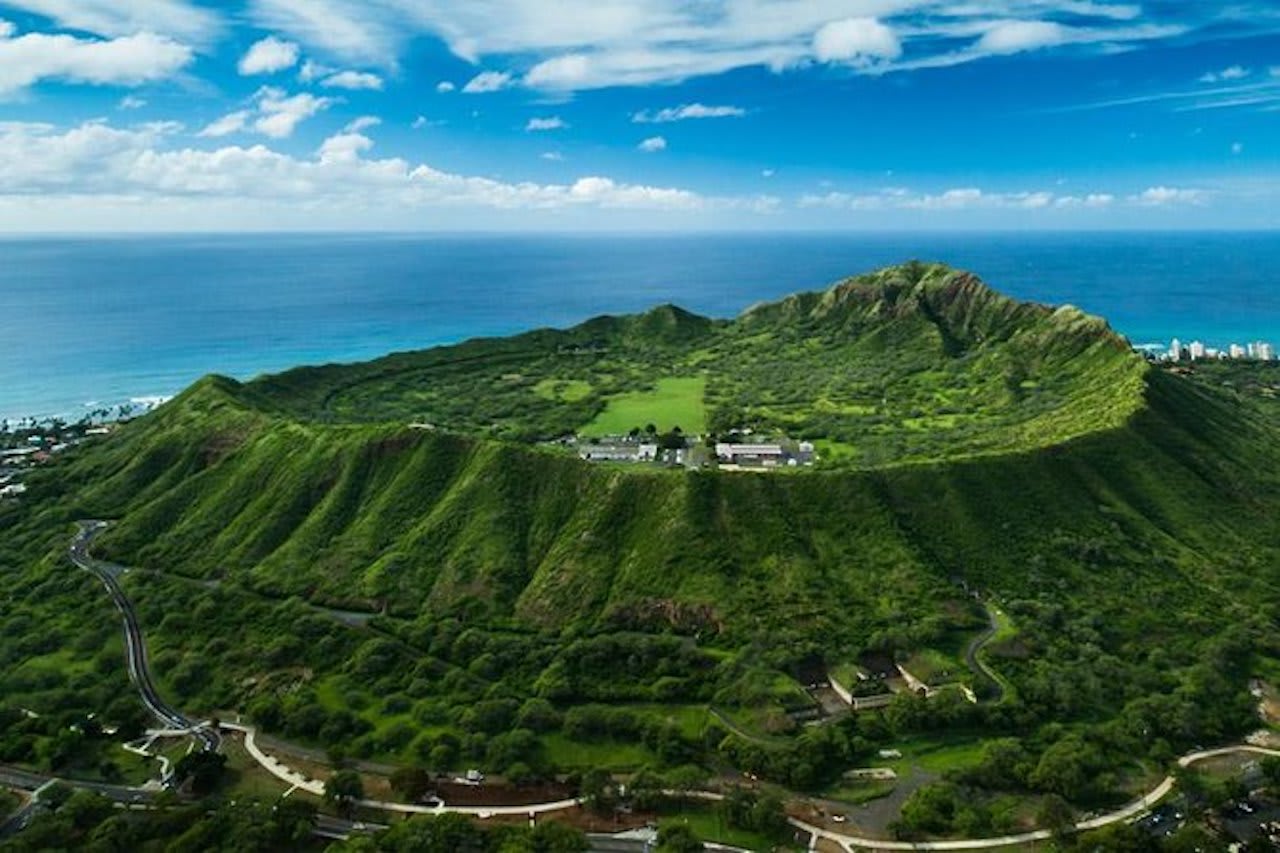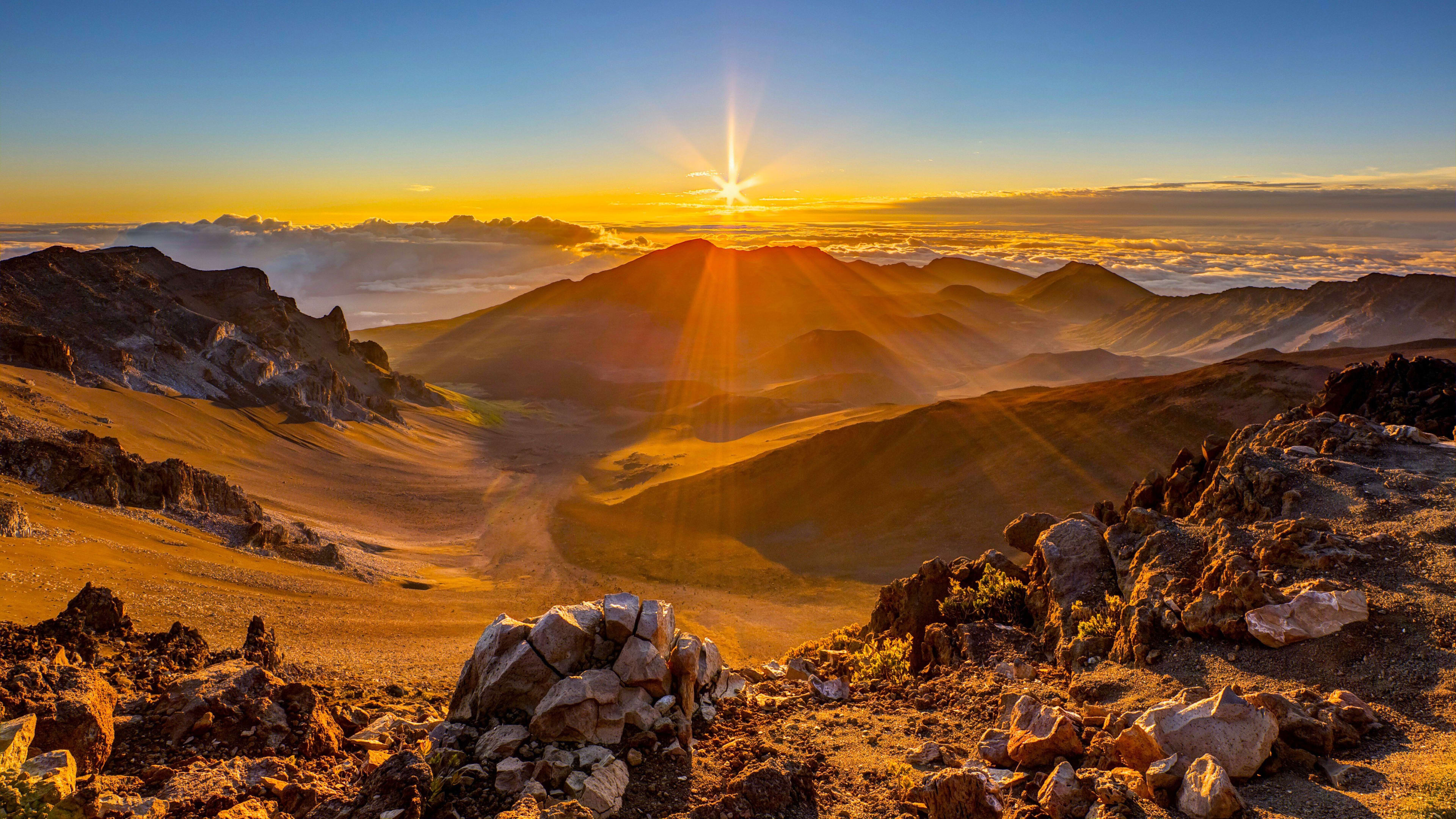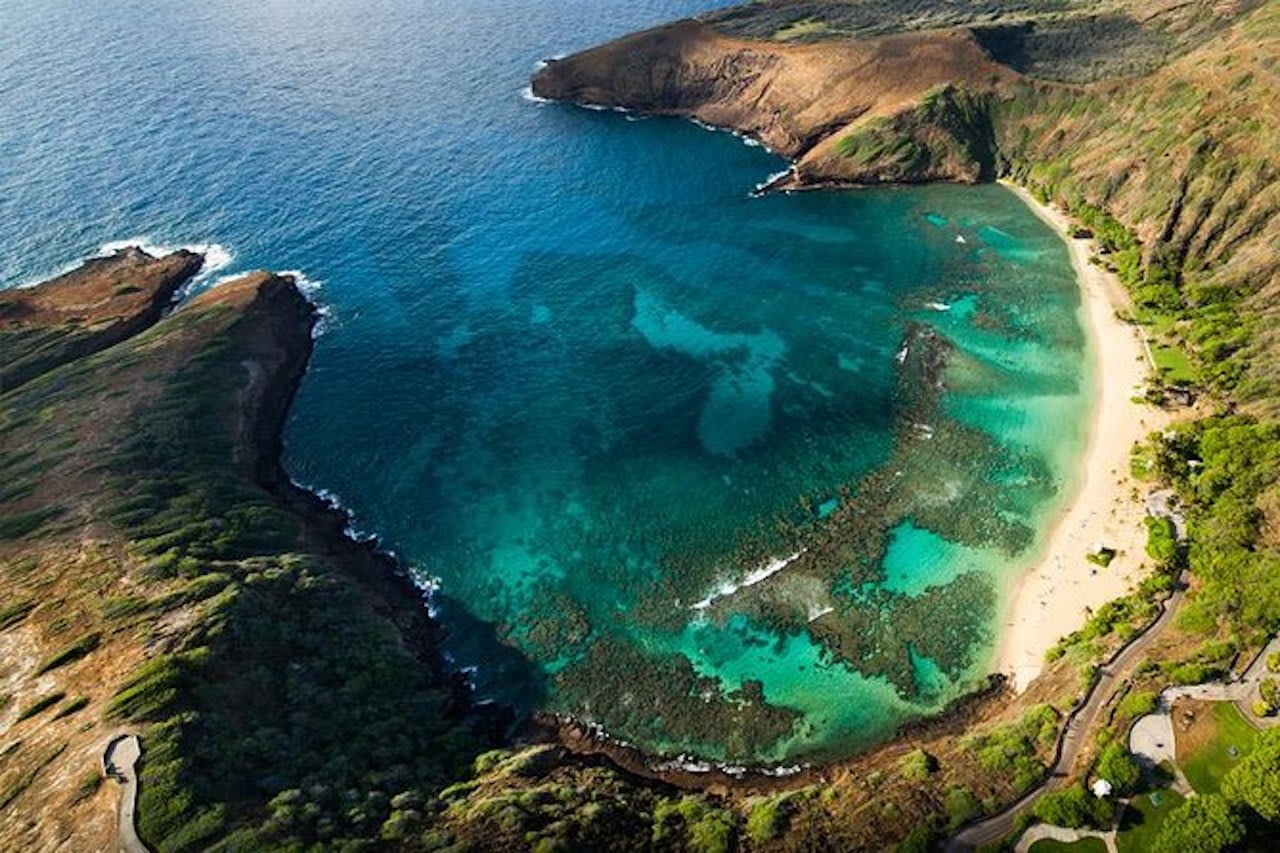The Volcanoes of Hawai'i

The Hawaiian Islands were formed by ancient volcanoes, and while most of the islands do not have active volcanoes today, volcanoes still remain an integral part of the Hawaiian culture and landscape!
5 million years ago a thermal plume exploded through the pacific plate of the ocean’s crust and formed the beginnings of Kauai, Hawaii’s oldest island. As the pacific plate continued to move west, the Hawaiian hot spot located deep within the earth erupted with thermal plumes again and again, forming island after island. Now, the Hawaiian hot spot currently lies under the youngest of the Hawaiian islands, the Island of Hawai’i at the eastern end of the island archipelago. Due to this hot spot, there are currently three active volcanoes on the island of Hawaii, including two of the most active volcanoes in the world! While the other Hawaiian islands no longer have active volcanoes, evidence of their unerasable geology can be found in their many volcanic craters that accentuate their landscapes so beautifully.
According to Hawaiian legend, the Hawaiian islands were created by the goddess Pele herself, goddess of fire, lightning, wind, and volcanoes. Pele is short for Pelehonuamea, meaning ‘she who shapes the sacred land’. One day, Pele, one of six daughters and seven sons, with her fiery locks of hair and her fiery temper, was banished from her homeland of Tahiti by her father Kane Milohai, creator of the sky and heavens. Her exile was not for no reason, as Pele had seduced her sister Namakaokahai’s husband and they were embroiled in a heated battle. As Pele fled across the ocean, her sister, who was also goddess of the sea, continued to chase her. Everytime Pele found a hiding place and tried to create a firepit for her home, Namakaokahai would flood the pit. So Pele continued onwards until she dug her final fire pit at the summit of Kilauea, on the island of Hawaii, where her sister couldn’t reach her anymore. Pele still lives in Kilauea, and you can bear witness to her unquenchable spirit every time the volcano erupts!
Volcanoes are an integral part of Hawaii’s history and culture, and whether you want to explore the craters– which offer an astounding wealth of biodiversity on land or in water– or pay respect to Pele, continue reading for a comprehensive list of all the volcanoes (active, dormant, and craters) across the Hawaiian Islands!
Island of Hawai'i
The Big Island of Hawaii was initially formed by the joining of 6 volcanoes: Mahukona Volcano, Kohala Volcano, Mauna Kea Volcano, Mauna Loa Volcano, Hualalai Volcano and Kilauea. Today, Kohala and Mahukona (under the sea) are extinct, Mauna Kea is considered dormant, and Kilauea, Mauna Loa, and Hualalai are active.
Kilauea is the most active volcano on earth! In fact, Kilauea erupted continuously for the 35 years between 1983-2018, and has erupted at least dozens of times over the last few centuries. It is no wonder that Kilauea was chosen by the goddess Pele as her home!
Not long ago in 2022, Mauna Loa was the most recent Hawaiian volcano to erupt! Known as the largest active volcano in the world, Mauna Loa’s broad and gently rounded slopes make up over 50% of the Big Island’s land mass, and starting from the bottom of the sea, which bends under the weight of this behemoth, rises up 30,000 feet (9,144 metres) – greater in height than Mount Everest! Mauna Loa has erupted 43 times since 1843, and averages one eruption every 5 years. The volcano is located remotely within Hawaii Volcanoes National Park meaning that its eruption doesn’t pose an immediate risk to residents and its non-explosive nature means that it can be visited safely when not erupting, either by car, helicopter, or on foot! Another great way to see Mona Loa, especially when it is erupting, is from the peak of Mauna Kea!
Mauna Kea is the highest peak on the island of Hawaii, and is often covered in a dusting of snow! Considered a dormant volcano, Mauana Kea last erupted 4,500 years ago, and it is likely to erupt again in the future. Mauna Kea is a sacred site for Hawaiians who often perform cultural and spiritual rituals at the summit which is seen as the symbolic piko (umbilical cord) between the heavens and the earth. If you do decide to visit, it is imperative to keep in mind how important this site is and to treat it with the utmost respect (as you should with all of Hawaii’s incredible natural spaces). The best way to access the summit is by a tour from Kona – as you are driven from the city all the way to the volcano's summit, you will pass through 7 different climate zones!
The third youngest, third most active, and westernmost volcano on the island of Hawaii is Hualalai. Its last eruption occurred in 1801 and it is expected to erupt again sometime in the next 100 years.
The Big Island’s many volcanoes add to its mythical, spiritual, cultural and biodiverse nature! It is impossible to miss the significance of volcanoes when visiting the island of Hawaii, and it is absolutely worth adding Hawaii’s Volcanoes National Park, which encompass the summits of Kilauea and Mona Loa, or a trip to Hawaii’s other volcanoes to your Big Island bucket list!
Maui
To the west of Hawaii’s Big Island, is the next youngest island of Maui. Maui is made of two volcanoes, Haleakala, which makes up 75% of the island, and Mauna Kahalawai which makes up the remaining 25%. Haleakala’s most recent eruptions happened between 1480 and 1600, while Mauna Kahalawai last erupted 420,000 years ago.
Haleakala is one of the most visited volcanoes in Hawaii and a site of cultural and spiritual significance. The volcano is the 10th highest mountain in the US, and its Hawaiian name means ‘house of the sun’. There is no better way to experience the incredible energy of Haleakala than by watching the sunrise from its summit! Check out this sunrise watching and bike ride tour of Haleakala for the perfect way to visit this spectacular volcano!

Molokai & Lana'i
Like their predecessors, the islands of Molokai and Lanai, located off the coast of Maui, were also formed from volcanoes.
Molokai is predominately made up of the East Molokai Volcano, also known as Wailau, and the West Molokai Volcano, a flat shield volcano. There is also the Kauhako crater located on the Kalaupapa peninsula. The crater and lava tube form one of the deepest lakes in the world – more than 800 feet deep!
The smaller island of Lanai was formed from one volcano, Mount Lānaʻihale, whose summit makes up the central part of the island.
Inbetween Maui, Molokai, and Lanai is the Molokini crater. Only a dark slender crescent of the crater can be seen above water, but inside the arms of the crater, Molokini is an incredible underwater marine sanctuary! The flourishing coral reef inside the crater is home to thousands of fish and other marine life, and the crystal clear waters by the crater make snorkelling here such a pleasure! Molokini is one of the best spots to snorkel in the Hawaiian islands – check out this Molokini crater snorkelling tour so that you don’t miss it!
O’ahu
Being the 2nd oldest of the Hawaiian islands, the main island of Oahu does not have any active or dormant volcanoes, but evidence of its ancient volcanic activity are everywhere and are a significant part of the island. Oahu first emerged from the sea around 4 million years ago as the Wai’anae volcano. A couple million years later came the Ko’olau volcano which makes up most of the island’s mass. Both volcanoes have since endured significant erosion with parts falling back into the ocean, and can now be appreciated as the Wai’anae mountain range and the Ko’olau mountain range – ancient volcanic ridges that give Oahu its unique texture and shape! During a later stage bout of volcanic activity, the diamond head crater, punchbowl crater, and hanauma bay crater were created.
An iconic part of the Honolulu skyline, and perhaps Hawaii’s most recognised monument, is the Diamond Head crater rising golden and green at the end of Waikiki. The crater was formed 300,000 years ago after a single explosion! The imposing crater is absolutely worth a visit and offers a fun and easy/moderate hike to its summit where you will have beautiful views across Waikiki, Honolulu, and the Pacific Ocean. For a special view of the crater while at sea, check out this snorkelling excursion that will have you snorkelling with turtles right in front of Diamond Head!
Also the result of another volcanic vent, the famous Hanauma Bay, with its incredible coral reef, thriving sealife, and shallow sparkling waters is the flooded remains of a crater! Walking down to shore from the top of the craters ridge, you can really appreciate the crater ring and unique shape of the beach. This amazing snorkelling location is a must-see when visiting Oahu!
The Punchbowl crater is harder to catch a glimpse of since it is located in the centre of Honolulu and its crater shape is hidden among the cityscape. It is now the site of the National Memorial Cemetery of the Pacific.
One of the younger craters on Oahu is Kokohead crater located adjacent to Hanauma Bay. Often mistaken for a funny looking hill, Kokohead is really a well preserved volcanic cone! A steep path leads from base to summit and makes for a great hike, but not for the faint hearted: the 1.5 mile path is lined with over 1,000 steps and becomes near perpendicular towards the top! Once you get there however, you will be rewarded with the most incredible views over the island!
To ensure that you can appreciate the magnitude of all these magnificent sights, check out this helicopter tour of the island that will let you peek right into the Diamond Head crater among other things!

Kaua'i
The oldest of the Hawaiian islands and formed over 5 million years ago, Kauai was created from a single eroded shield volcano. Kauai’s last eruption occurred over 400,000 years ago, and while there may not be any craters on the island, there is still evidence of its volcanic past!
One of the island’s most renowned features are the breathtaking ridges of the Na Pali Coast, which are the result of a volcanic lava flow that has been eroded over millions of years to give way to winding valleys and glorious waterfalls. The heavy erosion from rain and sea is not only eroding the island’s interior – which has also given way to the astonishing formations of the Waimea Canyon– and shores, but has also made way for many creeks, rivers, and streams that add to the lush character of the ‘garden island’!
Being the oldest of the Hawaiian islands has given Kauai a distinct beauty caused by intense erosion. As millenia go by, the rest of the Hawaiian islands will follow suite as they too continue to be heavily eroded by wind and water -- forever evolving and changing thanks to their volcanic origins.
The volcanic history of the Hawaiian Islands are integral to their nature. While the islands are a result of the same volcanic hotspot, due to differences in age and volcanic activity, each island has their own distinguishing characteristics! As such, each island has much to offer, from swimming with manta rays on the Big Island to kayaking in Oahu, but when visiting Hawaii, don’t forget to appreciate the volcanoes that made these islands what they are today!
However, the volcanoes that made Hawaii are not just part of the island chain's past and present, but also their future! The Hawaiian hotspot is still at hard at work, and as the Pacific plate has continued to move west, off the eastern shores of the island of Hawaii, a new Hawaiian island, already named Loihi, is brewing beneath the waves!